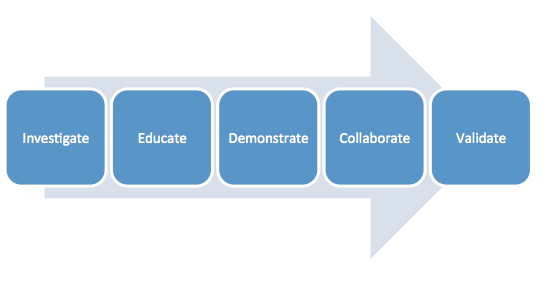Sales Managers as Agents of Change
Editor’s Note: Today we are posting Chapter 2 of a 10-chapter book, authored by our CSO, John Golden and Matt McDarby, President of United Sales Resources.
John and Matt have collaborated before and have joined forces with this book to provide expertise to help our readers — particularly Sales Managers who effectively manage salespeople in a social selling era. While there is currently plenty of information about social selling (including a book by co-author John Golden), there is a clear need for more information about how to manage a social sales team.
Without Sales Managers who believe in the benefits of social selling and know how to help and guide their salespeople to adopt social selling techniques, sales teams will not be successful at social selling.
We’re publishing the entire book in installments. Every three weeks or so we will post a chapter of the book — outlining 10 simple rules to:
- Equip Sales Managers to help their sales teams unlock the power of social selling.
- Show Sales Managers how to align their sales teams with the new and evolving buyer behaviors.
- Enable Sales Managers to create a culture and environment in which social selling is not just accommodated, but embraced.
- Teach Sales Managers how to effectively coach and mentor social selling excellence.
The role of Sales Manager is one of the most important in any organization, and yet they these employees are often the most under-supported, under-trained, under-invested in, and especially — misunderstood. As if that’s not enough, they also usually take a disproportionate amount of blame when sales numbers go south. – John Golden
Thanks to the advent of social media and its impact on buyer behavior, it is more critical than ever for Sales Managers to understand how to effectively lead their salespeople in the emerging era of social selling.
We encourage you to comment, ask questions, and offer your own insights. After all 10 chapters are published on the blog, we will make the book available in our Sales Reference Library as a free download.
*****
The Sales Manager as Agent of Social Change
Anthony Robbins (the self-help guru) has a catchphrase: “Where focus goes, energy flows.” This can very much be applied to sales management. For example, we have written extensively in the past about how the sales manager who focuses on the early stages of the pipeline creates a culture within the sales organization where properly targeting and rigorously qualifying opportunities become standard practice and the energy generated is controlled and efficient.
Then we have contrasted this with the sales manager who focuses late in the pipeline, parachutes in to help nudge (elbow even) deals across the line. This creates a culture in which everything is reactive, and as a result the energy generated is of the nervous and chaotic variety. The point is a simple one; where the sales manager puts his focus is where their sales people will in turn put their focus. Salespeople by the very nature of their job continually observe human behavior looking for clues that will help them figure out what motivates or is important to a prospect and it is no different when they observe their sales manager.
So given the Sales shift that social selling represents, the sales manager has a pivotal role in evaluating firstly whether his team should actually make the shift (and if so to what degree) and secondly that the move is managed and deliberate. But it doesn’t stop there; social selling cannot truly succeed without other constituencies in the organization believing in it and supporting it.
The sales manager therefore has to look beyond just his own team and reach out and influence other departments — and indeed the company leadership itself. If they succeed in persuading everyone to hitch their wagons to the social selling train they have to be able to prove that this new direction is actually delivering results. In other words, they have to become the agent of social (selling) change within the organization.
Now, as we all know the role of the sales manager is already one of the most demanding and difficult jobs overall. The average tenure of a sales manager is 18 months, which pretty much underlines the challenging nature of the job at the best of times before we even add paradigm shifts into the equation! In recognition of this fact we have created an easy to follow, 5-step model that can guide sales managers through this process of change:
The Social Model
Step 1: Investigate
The last few years have proven that social selling can be extremely successful when leveraged by the right sales team in the right industry with the right profile of customer. We choose our words deliberately here because the first step of our “social change” model is for the sales manager to establish the suitability of social selling to their particular target buyer. This is a critical step because there are some buyers for whom social selling does not make sense. Some financial services market segments, for example, cannot utilize social selling methods due to security, privacy, or compliance considerations, because access to and use of social media is severely restricted.
So the first thing the sales manager must do is take a look at their ideal target customer and do some analysis as to their buying habits and buying preferences. The best approach to doing this is to simply take the time to interview customers and assess how much social media and self-discovery is playing a role in how they buy. Here is one way we suggest doing this:
-
Select 3 or 4 recent successful sales.
-
Interview these new customers, ask them to walk through their buying process focusing particularly on how much social media, online professional networks, and easily accessible marketing assets (such as video, whitepapers etc.) played a significant role.
-
Select a cross-section of existing customers (small, medium, large) and do the same.
-
Interview them, ask them whether their buying process or habits have changed since the last sale.
-
Reach out to some of the late-stage prospects where opportunities were lost, and ask if they would be willing to give feedback on how they made their decision.
-
Interview them, asking them about the role social media played in their decision process.
Armed with this information, the sales manager can now make an informed decision as to the applicability of social selling, the degree to which it should be adopted and the speed at which the sales team should move in that direction.
Step 2: Educate
Assuming that the information gathered clearly demonstrates that adopting social selling practices makes sense, the next step of the process is for the sales managers to begin to educate both themselves and their sales team on how best to approach social selling and what tools and tactics to leverage. This was a much greater challenge two or three years ago in the early days of social selling as there were not many books or training programs available to help — but today a wealth of resources is available.
We would highly recommend that sales managers put themselves through a formal social selling training program first before they do the same with any of their salespeople. This is important for a number of reasons — not least because they need to be able to adapt the material to what they learned about their target customers in Step 1, and also because if they are going to encourage, mentor, and manage the adoption of social selling with the sales team, then they need to know what they are talking about.
As regards the selection of the right training program/provider, the advice we would offer is simply that you do your homework. Ask the training provider what experience they have had in your industry and with your type of customer. Then make sure the training provider is actually a practitioner rather than a theorist and that they have a proven track record of successful social selling.
Step 3: Demonstrate
As we’ve said, salespeople takes their cues on what is important from what their manager focuses on. So, post-education it is critically important that the sales manager leads by example and adopts the tools and tactics recommended during the training. They should provide a model for how these are integrated into their daily work practice and then work hands-on with their sales team to ensure they do the same.
This has to be reinforced in their regular interactions with their salespeople. Opportunity reviews, for example, would now include asking questions around what the salesperson has learned about the different people involved in the purchasing decision from their online profiles or what pertinent things they have picked up on from online industry-specific discussions.
Again, in the words of Mr. Robbins, “Where focus goes, energy flows” and the more the sales manager focuses on the social selling aspects of a sale, the more the salesperson will.
Another key element the sales manager can tackle is creating the environment and culture where social selling can flourish. A simple example of this is networking. Traditionally most sales managers would encourage their salespeople to regularly invest a few hours at local, physical networking events but now those same sales managers have to equally encourage them to invest time online, researching, connecting, and interacting with prospective buyers and influencers. In other words, the sales manager cannot afford to send the message that physical networking is good but virtual networking is not — or else their push for social selling adoption will quickly be seen as the fad du jour.
Step 4: Collaborate
Next, leveraging the research about the targets’ buying process, the sales manager needs to co-opt other groups in the organization to align with this process.
The first group is obviously Marketing. Given that there is a plethora of research to show that the buyer is often a significant way through their buying process before they engage directly with a seller, their role in supporting this buying process has increased significantly. Armed with the intelligence gained from their conversations with customers during the investigation, the sales manager needs to engage with Marketing and collaboratively define how they can help enable the self-discovery part of their buying process. Together they need to ensure that there is valuable and insightful information readily available to buyers during this phase, and that the information is deployed in whatever format the buyers prefer (e.g. whitepaper, video, infographic), and on whatever platforms they leverage (e.g. company website, YouTube, LinkedIn, Twitter).
Additionally the sales manager can help enlist Marketing to provide salespeople with concise and targeted content to share with buyers and in professional networking groups. Plus, they can teach salespeople how to communicate online in a way that quickly resonates with their audience.
Another constituency the sales manager needs to involve is the company leadership. While not an easy task, there is enough research available that shows how customers trust and relate better to organizations where the senior leadership (especially the CEO) is active on social media. This kind of visibility/transparency engenders greater feelings of trust and connectedness. While we understand that many sales managers may be reluctant to approach their CEO and just ask them to get busy on social media, remember that if a CEO is aware that they can help increase sales by putting their name to a weekly blog post written by Marketing how many would really refuse?
Two other groups that the sales manager should consider engaging are customer service and implementation. They are the ones most involved with customers post-sale—a golden time to learn more about customers. Given that every implementation of products or services has some differences, however subtle, there are always new insights to be gained. The salespeople in their online engagement can then use these valuable insights in their dialogs with potential customers.
Step 5: Validate
As with any new initiative, the proof is in the pudding, Given how social selling can often be quite incremental in its impact or even come across as tangential to how most selling processes have traditionally flowed, defining metrics and success criteria is critical.
We will deal with this more in a later chapter but suffice to say at this point, that any sales manager who takes on this role as the agent of social change within their organization will have to navigate through times (particularly early in the process) where the impact of social selling is not readily visible. To mitigate this, the sales manager will need to identify leading indicators that can demonstrate future direct revenue impact. These leading indicators will be needed not just to persuade management that social selling is worth sticking with but also to allow the sales manager to demonstrate to their salespeople that the return on their adoption will pay off.
As we said at the outset, the sales manager’s role is a demanding one at the best of times but becoming the agent of social change by following the model outlined could actually turn out to be one of the most rewarding and far-reaching initiatives they ever introduce.
Coming In The Next Chapter:
In the next chapter, we will go deeper with how the Sales Manager needs to educate salespeople on the importance of establishing a personal brand in the marketplace — and the part this plays in the buying process. Prospective customers do not just research a vendor’s company, they also research the individual salesperson so sales managers need to ask their salespeople “Exactly who are you?” when a customer reviews your online profile? What does your online profile communicate about you?
Get your free trial of Pipeliner CRM now.















